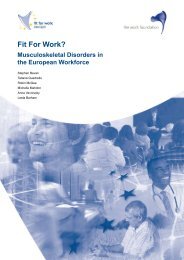English version - Fit for Work Europe
English version - Fit for Work Europe
English version - Fit for Work Europe
You also want an ePaper? Increase the reach of your titles
YUMPU automatically turns print PDFs into web optimized ePapers that Google loves.
• Indirect costs including lost work output attributable to a reduced capacity <strong>for</strong> activity,<br />
such as lost productivity, lost earnings, lost opportunities <strong>for</strong> family members, lost<br />
earnings of family members and lost tax revenue;<br />
• Intangible costs including psychosocial burden resulting in reduced quality of life, such<br />
as job stress, economic stress, family stress and suffering (WHO, 2003).<br />
These costs vary considerably depending on the condition, on the severity of the symptoms,<br />
and whether these cause short or long-term absence or disability. Moreover, they vary<br />
depending on the particular methods used to calculate the costs. Some factors which affect the<br />
calculations include the following:<br />
• Severity of patient’s conditions;<br />
• Mix of patient demographics in a study;<br />
• Calculation method <strong>for</strong> productivity;<br />
• Definitions of work disability;<br />
• The treatment costs or outcomes due to treatments;<br />
• Change in health care financing systems;<br />
• Incidence or prevalence based estimates of costs.<br />
Introduction<br />
The biopsychosocial model (Waddell and Burton, 2006b) advocates taking into consideration<br />
the interplay between the biological (eg disease, joint damage), the psychological (eg<br />
disposition, anxiety) and the social (eg work demands, family support) factors, when assessing<br />
the overall impact of chronic health conditions. The psychological status and behaviour of<br />
a patient can be equally affected by a ‘physical’ injury (such as back pain), and should be<br />
addressed during treatment and rehabilitation. It is evident that the interaction of the biological,<br />
psychological and social dimensions defines the long-term impact of a musculoskeletal<br />
condition.<br />
While it is hardly possibly to quantify the exact burden of MSDs on individuals, employers and<br />
the wider society, it is clear that reduced workability contributes to the indirect and intangible<br />
costs of MSDs, which are eventually greater than the direct costs of treatment (Lundkvist,<br />
Kastäng and Kobelt, 2008). A number of stakeholders including policy makers, health care<br />
professionals, employers and individuals have to work together to anticipate the negative<br />
impact of MSDs in time <strong>for</strong> the most efficient prevention and management of the effects of those<br />
conditions.<br />
<strong>Fit</strong> For <strong>Work</strong>? Musculoskeletal Disorders and the Japanese Labour Market 11







